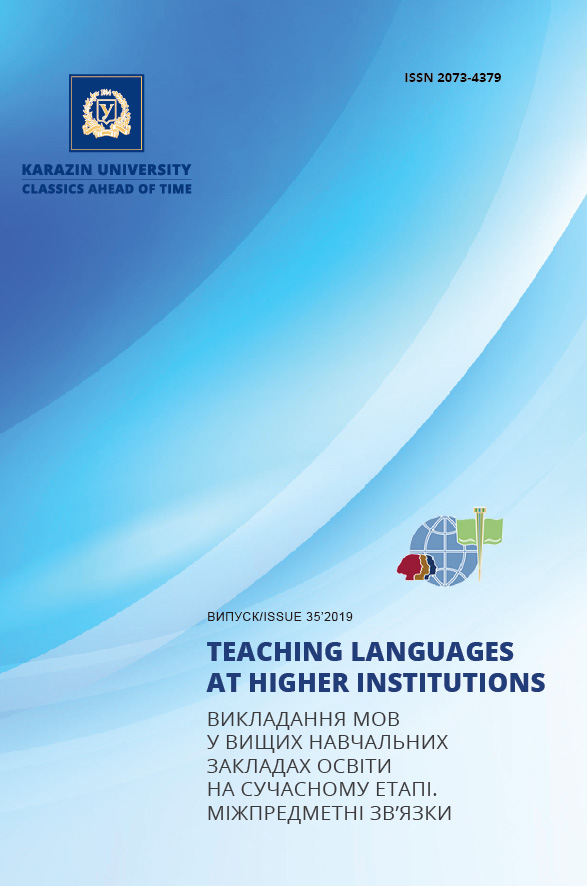Педагогічна граматика як фреймове поняття для досліджень у галузі методики навчання іноземних мов. Частина 7. Засвоєння синтаксису рідної мови: концептуальна складність
Анотація
Наводяться результати аналізу даних досліджень у згаданій сфері. Виходячи з високого ступеня подібності таких результатів, сформульовано висновок про те, що зміст засвоєння синтаксису англійської мови як рідної базується на певних етапах. Ґрунтуючись на результатах аналізу, запропоновано висновки про зміст етапів засвоєння структур розділового запитання, заперечення, пасивних конструкцій та відносних речень, а також про умови появи повністю інвертованих розділових запитань у мовленні дитини та можливих каталізаторах цього процесу. Розглянуто вплив принципу мінімальної віддаленості на вірність тлумачення дітьми різного віку відносних речень, а також тих, що містять пасивні конструкції. Запропоновано тезу про поступовий характер формування концептуально ускладнених синтаксичних категорій, зокрема, про різну швидкість поширення правил уживання пасивного стану на дієслова, що передають дії та стани. Сформульовано висновок про чинники, що впливають на послідовність і швидкість засвоєння синтаксичних засобів, які включають семантичну та граматичну складність, частотність і перцептуальну випуклість. Окреслено перспективи подальшого дослідження з урахуванням отриманих результатів в процесі розробки педагогічної граматики іноземної мови.
Завантаження
Посилання
Brown, R. (1973). A First Language: The Early Stages. Cambridge, Mass.: Harvard Univ. Press [in English].
Chernovaty, L. (1999). Osnovy teorii pedagogicheskoi grammatiki inostrannogo yazyka [The Basics of the Foreign Language Pedagogical Grammar Theory]. Doctor of Sciences thesis. Kharkiv: V.N. Karazin Kharkiv National University [in Russian].
Chernovaty, L.M. (2018). Pedagogical grammar as the framework of research in teaching foreign languages. Part 5. Native language morphology acquisition at the simple sentence stage. Vykladannia mov u vyshchykh navchalnykh zakladakh osvity na suchasnomu etapi. Mizhpredmetni zviazky [Teaching Languages at Higher Institutions], 33, pp. 118–126 [in English].
Chernovaty, L.M. (2018). Pedagogical grammar as the framework of research in teaching foreign languages. Part 6. Native language syntax acquisition: yes-no- and why-questions. Vykladannia mov u vyshchykh navchalnykh zakladakh osvity na suchasnomu etapi. Mizhpredmetni zviazky [Teaching Languages at Higher Institutions], 34, pp. 246–257 [in English].
Chierchia, G., Crain, S., Guasti, M., Gualmini, A. and Meroni, L. (2000). The acquisition of disjunction: Evidence for a grammatical view of scalar implicatures. Proceedings of the 25th Boston University Conference of Language Development. Somerville, MA: Cascadilla Press, pp. 157–168 [in English].
Crain, S., Gardner, A., Gualmini, A.and Rabbin, B. (2002). Children’s command of negation. Yukio Otsu (Ed.). Proceedings of the third Tokyo Conference on Psycholinguistics. Tokyo: Hituzi Publishing Company, pp. 71–95 [in English].
Crain, S., Goro, T. and Thornton, R. (2006). Language Acquisition is Language Change. Journal of Psycholinguistic Research, 35 (1), pp. 31–49. DOI: 10.1007/s10936-005-9002-7 [in English].
de Villiers, J. and de Villiers, P. (1978). Language Acquisition. Cambridge, Mass.: Harvard Univ. Press [in English].
Dimroth, Ch. (2010). The acquisition of negation. Horn, L.R. (Ed.). The expression of negation. Berlin: De Gruyter Mouton, pp. 39–73. DOI: 10.1515/9783110219302.39 [in English].
Erreich, A., Valian, V. and Winzemer, J. (1980). Aspects of a theory of language acquisition. Journal of Child Language, 2, pp. 157–179 [in English].
Goro, T. and Akiba, S. (2004). The acquisition of disjunction and positive polarity in Japanese. Garding, G. and Tsujimura, M. (Eds.). Proceedings of WCCFL 23. Somerville, MA: Cascadilla Press, pp. 101–114 [in English].
Gualmini, A., Crain, S. and Meroni, L. (2000). Acquisition of disjunction in conditional sentences. Proceedings of the 24th Boston University Conference of Language Development. Somerville, MA: Cascadilla Press, pp. 367–378 [in English].
Ingram, D. (1992). First Language Acquisition. Cambridge: Cambridge Univ. Press [in English].
Islam, Y. (2015). Phases in L1 Acquisition of Negation: A Comparative Study of Cairene Arabic and English. SKASE Journal of Theoretical Linguistics, 12 (4), pp. 17–27 [in English].
Kusmanto, J., and Pulungan, A. (2003). The acquisition of English negation “no” and “not”: evidences from an Indonesian child in non-native parents bilingual program. K@ta: a Biannual Publication on the Study of Language and Literature, 5 (1), pp. 41–48 [in English].
Notley, A., Zhou P., Jensen B. and Crain, S. (2012). Children’s interpretation of disjunction in the scope of “before”: A comparison of English and Mandarin. Journal of Child Language, 39 (3), pp. 482–522 [in English].
Tieu, L., Yatsushiro, K., Cremers, A., Romoli, J., Sauerland, U. and Chemla, E. (2017). On the Role of Alternatives in the Acquisition of Simple and Complex Disjunctions in French and Japanese. Journal of Semantics, 34 (1), pp. 127–152. Available at: https://doi.org/10.1093/jos/ffw010 [in English].

